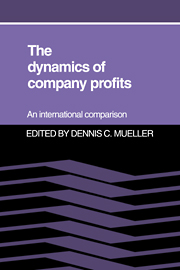Book contents
- Frontmatter
- Contents
- Preface
- Contributors
- 1 Profits and the process of competition
- 2 Modeling persistent profitability
- 3 The persistence of profits in the United States
- 4 The persistence of profits in U.S. manufacturing industries
- 5 The persistence of profitability in Canada
- 6 The persistence of corporate profits in the Federal Republic of Germany
- 7 The persistence of profits in France
- 8 The persistence of profits in Japan
- 9 The persistence of profits in the United Kingdom
- 10 The persistence of profits: international comparison
- 11 The persistence of profits in perspective
- References
- Index
4 - The persistence of profits in U.S. manufacturing industries
Published online by Cambridge University Press: 03 May 2010
- Frontmatter
- Contents
- Preface
- Contributors
- 1 Profits and the process of competition
- 2 Modeling persistent profitability
- 3 The persistence of profits in the United States
- 4 The persistence of profits in U.S. manufacturing industries
- 5 The persistence of profitability in Canada
- 6 The persistence of corporate profits in the Federal Republic of Germany
- 7 The persistence of profits in France
- 8 The persistence of profits in Japan
- 9 The persistence of profits in the United Kingdom
- 10 The persistence of profits: international comparison
- 11 The persistence of profits in perspective
- References
- Index
Summary
In this chapter we develop and test a simple autoregressive model that describes the profits of industries over time. The model explicitly addresses the issue of incomplete adjustments of profitability and distinguishes longrun from short-run effects. The model is fit to census data on U.S. manufacturing industries over the period 1967–82. Industry-specific estimates of the speed of adjustment of the profit rate toward its long-run equilibrium level and hence measures of the degree of persistence in performance across the various industries are obtained. These estimates are then linked to structural characteristics that theory suggests might be pertinent in determining the rate at which the forces of competition erode excess returns. The results of the chapter provide support for the view that competition in an industry is rooted in its underlying economic structure. We find support for both the Chamberlinian hypothesis and the more recently advanced contestability conjecture that states that the performance of industries depends continuously on the degree to which they exhibit imperfect contestability.
A partial adjustment model
Let Πit denote the profit rate of industry i at time t. We postulate that the level of Πit reflects industry-specific characteristics determining both the internal conditions of actual competition among the established firms in the industry and also the external conditions of potential competition from outside firms. Among the internal conditions we include brand loyalties, cost and informational asymmetries, demand inelasticities, and so on. Prominent among the industry characteristics that determine the competitive pressure exerted by potential entrants is the height of entry barriers.
- Type
- Chapter
- Information
- The Dynamics of Company Profits , pp. 59 - 76Publisher: Cambridge University PressPrint publication year: 1990
- 14
- Cited by



